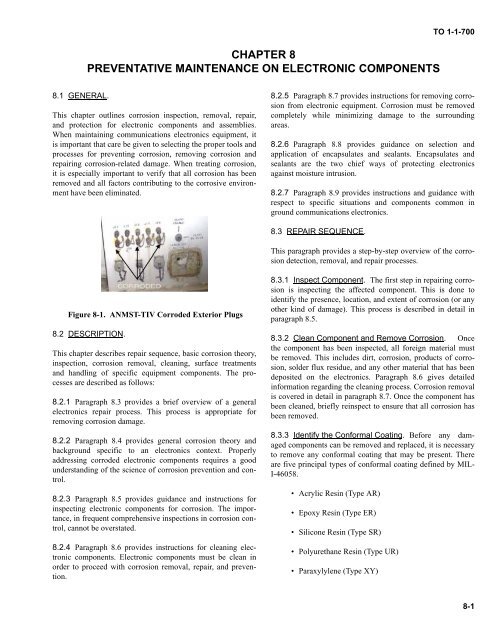TO 1-1-700 - Robins Air Force Base
TO 1-1-700 - Robins Air Force Base
TO 1-1-700 - Robins Air Force Base
Create successful ePaper yourself
Turn your PDF publications into a flip-book with our unique Google optimized e-Paper software.
CHAPTER 8<br />
PREVENTATIVE MAINTENANCE ON ELECTRONIC COMPONENTS<br />
<strong>TO</strong> 1-1-<strong>700</strong><br />
8.1 GENERAL.<br />
This chapter outlines corrosion inspection, removal, repair,<br />
and protection for electronic components and assemblies.<br />
When maintaining communications electronics equipment, it<br />
is important that care be given to selecting the proper tools and<br />
processes for preventing corrosion, removing corrosion and<br />
repairing corrosion-related damage. When treating corrosion,<br />
it is especially important to verify that all corrosion has been<br />
removed and all factors contributing to the corrosive environment<br />
have been eliminated.<br />
8.2.5 Paragraph 8.7 provides instructions for removing corrosion<br />
from electronic equipment. Corrosion must be removed<br />
completely while minimizing damage to the surrounding<br />
areas.<br />
8.2.6 Paragraph 8.8 provides guidance on selection and<br />
application of encapsulates and sealants. Encapsulates and<br />
sealants are the two chief ways of protecting electronics<br />
against moisture intrusion.<br />
8.2.7 Paragraph 8.9 provides instructions and guidance with<br />
respect to specific situations and components common in<br />
ground communications electronics.<br />
8.3 REPAIR SEQUENCE.<br />
This paragraph provides a step-by-step overview of the corrosion<br />
detection, removal, and repair processes.<br />
Figure 8-1. ANMST-TIV Corroded Exterior Plugs<br />
8.2 DESCRIPTION.<br />
This chapter describes repair sequence, basic corrosion theory,<br />
inspection, corrosion removal, cleaning, surface treatments<br />
and handling of specific equipment components. The processes<br />
are described as follows:<br />
8.2.1 Paragraph 8.3 provides a brief overview of a general<br />
electronics repair process. This process is appropriate for<br />
removing corrosion damage.<br />
8.2.2 Paragraph 8.4 provides general corrosion theory and<br />
background specific to an electronics context. Properly<br />
addressing corroded electronic components requires a good<br />
understanding of the science of corrosion prevention and control.<br />
8.2.3 Paragraph 8.5 provides guidance and instructions for<br />
inspecting electronic components for corrosion. The importance,<br />
in frequent comprehensive inspections in corrosion control,<br />
cannot be overstated.<br />
8.2.4 Paragraph 8.6 provides instructions for cleaning electronic<br />
components. Electronic components must be clean in<br />
order to proceed with corrosion removal, repair, and prevention.<br />
8.3.1 Inspect Component. The first step in repairing corrosion<br />
is inspecting the affected component. This is done to<br />
identify the presence, location, and extent of corrosion (or any<br />
other kind of damage). This process is described in detail in<br />
paragraph 8.5.<br />
8.3.2 Clean Component and Remove Corrosion. Once<br />
the component has been inspected, all foreign material must<br />
be removed. This includes dirt, corrosion, products of corrosion,<br />
solder flux residue, and any other material that has been<br />
deposited on the electronics. Paragraph 8.6 gives detailed<br />
information regarding the cleaning process. Corrosion removal<br />
is covered in detail in paragraph 8.7. Once the component has<br />
been cleaned, briefly reinspect to ensure that all corrosion has<br />
been removed.<br />
8.3.3 Identify the Conformal Coating. Before any damaged<br />
components can be removed and replaced, it is necessary<br />
to remove any conformal coating that may be present. There<br />
are five principal types of conformal coating defined by MIL-<br />
I-46058.<br />
• Acrylic Resin (Type AR)<br />
• Epoxy Resin (Type ER)<br />
• Silicone Resin (Type SR)<br />
• Polyurethane Resin (Type UR)<br />
• Paraxylylene (Type XY)<br />
8-1
















